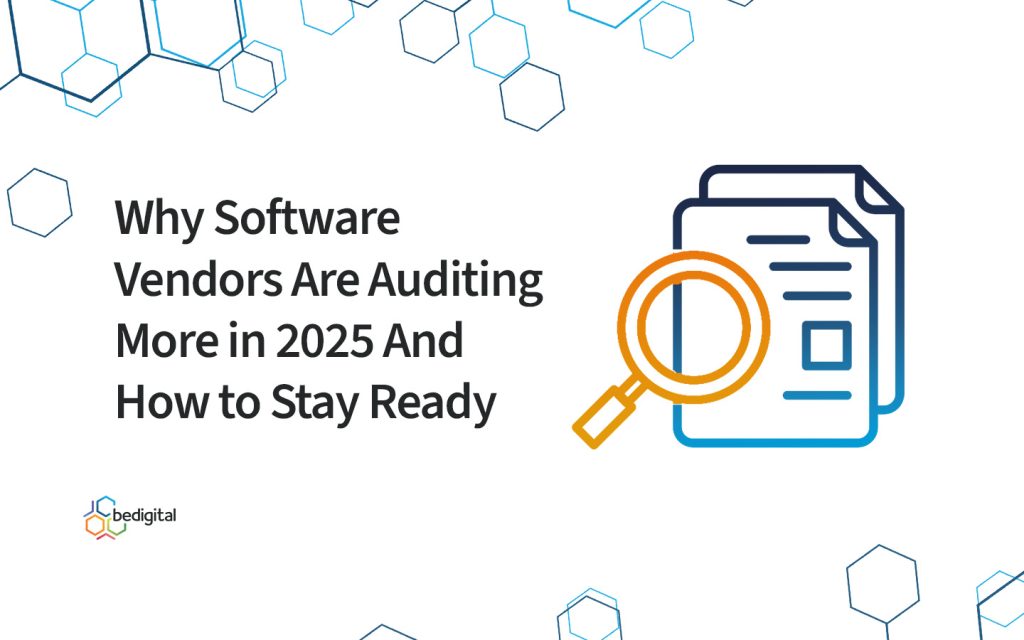Manufacturing organisations are no strangers to complexity. You’re expected to keep production running, drive digital transformation, and do it all within tight budgets. But there’s one area that keeps quietly challenging those goals: SAP licensing.
If your SAP environment feels increasingly difficult to manage or more expensive than it should be, you’re not alone. Manufacturers face unique challenges when it comes to SAP, and recent changes in licensing models haven’t made it easier.
At bedigital, we work with enterprise organisations across sectors, including manufacturing, to help them navigate SAP’s complexity. And if there’s one thing we’ve learned, it’s this: you can’t manage SAP licensing like just another procurement line item.
Here’s why, and what to do instead.
Licensing is no longer a back-office issue
Ten years ago, software licensing was mostly a finance concern. Negotiate a volume deal, monitor usage, and avoid audits. Done.
Not anymore.
SAP’s shift toward subscription-based licensing, the introduction of Full Use Equivalent (FUE) metrics, and the evolution of offerings like RISE with SAP (now rebranded in some tiers as SAP Cloud ERP) have fundamentally changed how organisations engage with SAP. Licensing decisions now influence IT architecture, transformation planning, and broader business strategy.
In manufacturing, where IT touches everything from the shop floor to supply chain logistics, licensing has quietly become a board-level issue, whether or not it’s being treated like one.
Why manufacturers get caught out
If you’re in manufacturing, you’re operating in one of the most licensing risk-heavy environments. Here’s why:
1. Complex and layered architectures
You might be running multiple SAP instances, some legacy (ECC), some in pilot (S/4HANA), and many loosely integrated. Add IoT platforms, MES systems, and third-party logistics tools feeding data into SAP, and you’ve got a licensing minefield.
2. Hidden indirect access
That robot arm sending usage data to SAP? Or the supplier portal accessing BOMs? Both could trigger indirect access liabilities you haven’t budgeted for, and SAP audits are designed to find them.
3. Bespoke contracts that no longer fit
Many manufacturing firms negotiated SAP contracts years ago, often after acquisitions or infrastructure changes. These contracts rarely align with SAP’s newer models, and trying to “modernise” them without proper analysis usually leads to overbuying.
4. No central SAP governance
You may have IT ownership spread across plants, regions, or business units. That decentralisation is great for agility… until it comes time to optimise licensing. Shelfware, duplication, and missed entitlements become inevitable.
The real problem: License management isn’t designed for change
The biggest mistake we see? Treating SAP licensing as static.
But manufacturing IT is dynamic. Plants upgrade equipment. Systems are integrated or retired. Automation increases. Data sources multiply. And with AI being considered by many organisations, understanding how AI is licensed just adds another layer of complexity. All this changes how SAP is accessed, and what you’re liable for.
Yet most manufacturers still rely on outdated license inventories, vendor-supplied estimates, or procurement-led contract reviews. That’s a recipe for overspend and audit risk.
To get ahead, you need a dynamic, structured approach to license governance, one that reflects your actual usage, future roadmap, and business priorities.
What good looks like: A smarter approach to SAP licensing
Here’s what manufacturing leaders doing it right are focusing on:
- Mapping reality to entitlement – Understanding what licenses you’ve bought vs. what you’re actually using (and who’s using it).
- Rationalising SKUs – Identifying shelfware, duplication, or products included by SAP “just in case” but never needed.
- Planning for indirect use – Quantifying automation and integration points before SAP flags them in an audit.
- Reviewing contracts line-by-line – Not just looking at overall discount levels, but spotting pricing tiers, bundling tricks, and cost escalators.
- Negotiating from insight, not instinct – Using hard data to shift from reactive renewal to proactive renegotiation.
Real-world example: A global manufacturer cuts SAP costs by 43%
One client, a multinational manufacturing group, came to us facing a tight SAP deadline. SAP had proposed a package that looked “reasonable” on the surface, but the details told a different story.
We helped them:
- Avoid unnecessary year-one SKUs
- Remove excessive support fees
- Correct suboptimal price tiers
- Identify shelfware across regions
- Secure price holds and custom clauses for long-term protection
The result? A 43% cost reduction vs. SAP’s initial discounted offer.
That’s not just savings, it’s strategic clarity and breathing room for IT investment.
Final thought: Don’t let licensing hold back your transformation
SAP licensing isn’t just a compliance issue. It shapes your IT estate, your transformation plans, and your ability to innovate.
You don’t need to be a licensing expert yourself, but it’s essential to ensure that someone with the right depth, independence, and technical expertise is overseeing this critical area.
That’s where we come in.
Key takeaways
- SAP licensing is changing fast and manufacturers are particularly exposed.
- Legacy systems, indirect access, and decentralised IT make compliance harder.
- SAP contract “discounts” can hide significant inefficiencies and overbuying.
- A structured, data-led approach reveals risks and savings, before SAP does.
- Partnering with specialists like bedigital brings clarity, leverage, and real value.
Want to uncover savings and reduce risk in your SAP estate?
Schedule a call with our team or download our latest whitepaper for more information: SAP S/4HANA Licensing & Strategy Guide for ECC and Transitioning Customers.


